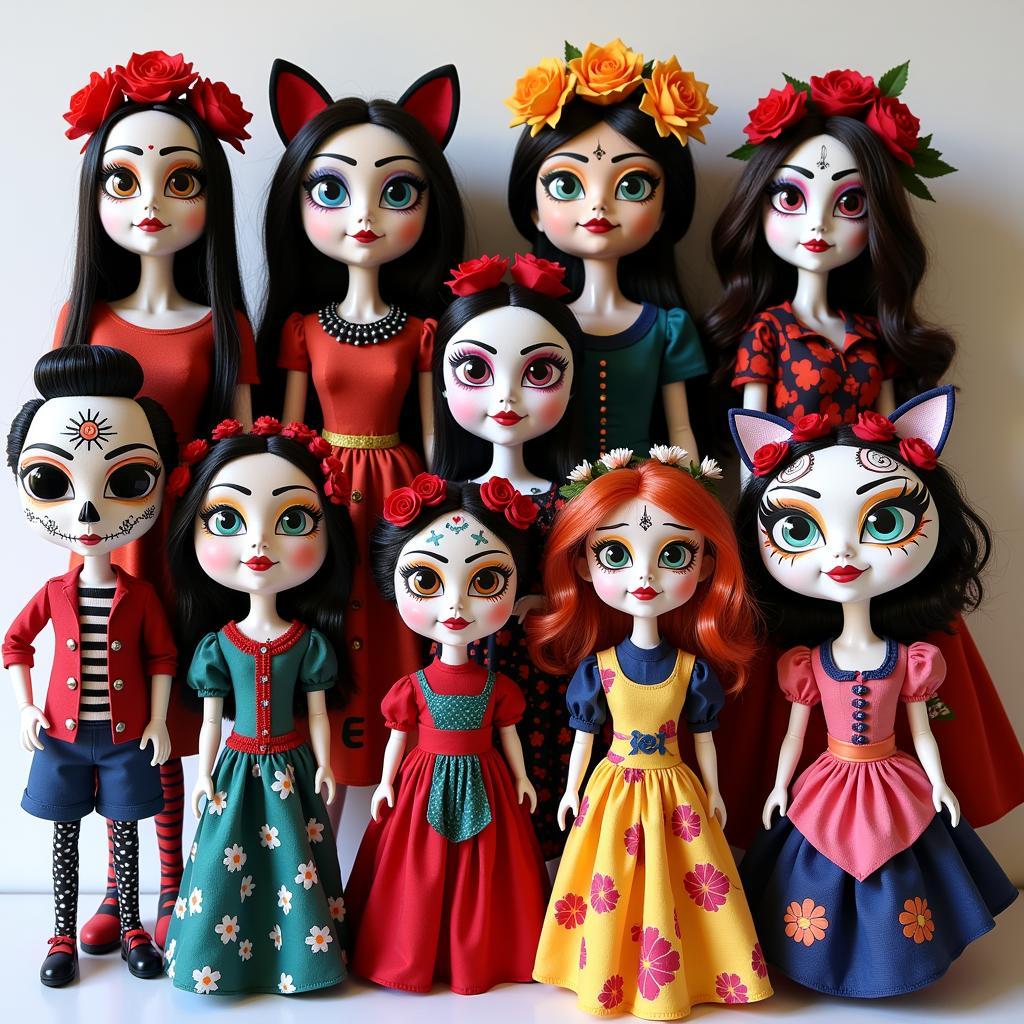Catrina Dolls Mexico are more than just decorative figurines; they are a vibrant symbol of Mexican culture and tradition, deeply intertwined with the celebration of Día de los Muertos, or Day of the Dead. These elaborately decorated skeletons, often adorned with colorful flowers and elegant attire, represent a unique perspective on life, death, and remembrance.
The Rich History of Catrina Dolls Mexico
The iconic image of La Catrina, the original inspiration for these dolls, emerged in the early 20th century from the etching of Mexican printmaker José Guadalupe Posada. Originally a satirical commentary on the upper class of Mexican society during the pre-revolutionary era, La Catrina, with her wide-brimmed hat and European-style gown, mocked those who, despite their indigenous heritage, aspired to emulate European fashion and lifestyle. Over time, this image was embraced and transformed into a symbol of Mexican national identity and a celebration of the Day of the Dead.
The evolution of La Catrina from a satirical figure to a beloved cultural icon reflects the dynamic nature of Mexican culture. Today, Catrina dolls are seen as a reminder of the cyclical nature of life and death, and a celebration of the lives of those who have passed. They are a testament to the Mexican belief that death is not an end, but rather a continuation of life in another realm.
Crafting the Catrina: Materials and Techniques
The creation of Catrina dolls is a meticulous process, often involving skilled artisans who employ a variety of materials and techniques. Traditionally, Catrina dolls are crafted from clay or papier-mâché, but modern variations can include materials like resin, wood, and even fabric.
The intricate details of the dolls’ faces, often painted with vibrant colors and intricate designs, are a testament to the skill and artistry of the creators. From the delicate flowers adorning their hair to the elegant patterns embellishing their dresses, each Catrina doll is a unique work of art.
The Significance of Catrina Dolls in Día de los Muertos
Catrina dolls play a central role in the Day of the Dead celebrations, adorning altars and homes as a symbol of remembrance and celebration. Families place these dolls alongside offerings of food, drinks, and personal belongings of their deceased loved ones, welcoming their spirits back to the world of the living for a brief reunion. The vibrant colors and festive decorations associated with the Catrina dolls contribute to the joyous atmosphere of the celebration, emphasizing the belief that death is not a time for mourning, but rather a time for celebration and remembrance.
Catrina Dolls: Beyond the Traditional
While traditional Catrina dolls remain popular, contemporary artists are constantly reimagining the iconic image, incorporating new materials, styles, and themes. From miniature figurines to life-sized sculptures, Catrina dolls have become a canvas for artistic expression, reflecting the evolving nature of Mexican art and culture.
 Modern Interpretations of Catrina Dolls
Modern Interpretations of Catrina Dolls
Conclusion: Embracing the Spirit of Catrina Dolls Mexico
Catrina dolls Mexico are more than just decorative objects; they are a powerful symbol of Mexican culture, tradition, and remembrance. From their origins as social commentary to their current status as cultural icons, these dolls represent a unique perspective on life, death, and the enduring power of memory.
FAQ
- What is the origin of Catrina dolls?
- What do Catrina dolls symbolize?
- How are Catrina dolls made?
- When are Catrina dolls used?
- Where can I buy authentic Catrina dolls?
- What are some modern interpretations of Catrina dolls?
- How can I incorporate Catrina dolls into my Day of the Dead celebration?
More Questions and Related Articles
- Exploring the Traditions of Día de los Muertos
- The Art of Sugar Skulls: A Symbol of Life and Death
- Mexican Folk Art: A Celebration of Culture and Tradition
Khi cần hỗ trợ hãy liên hệ Số Điện Thoại: 0909802228, Email: doibongda@gmail.com Hoặc đến địa chỉ: 101 Đ. Lý Chiêu Hoàng, Phường 10, Quận 6, Hồ Chí Minh, Việt Nam. Chúng tôi có đội ngũ chăm sóc khách hàng 24/7.